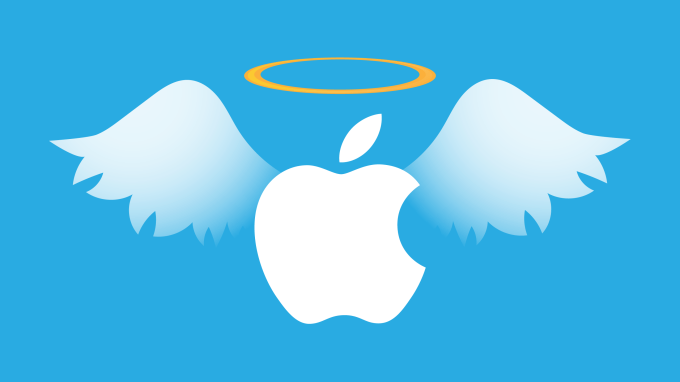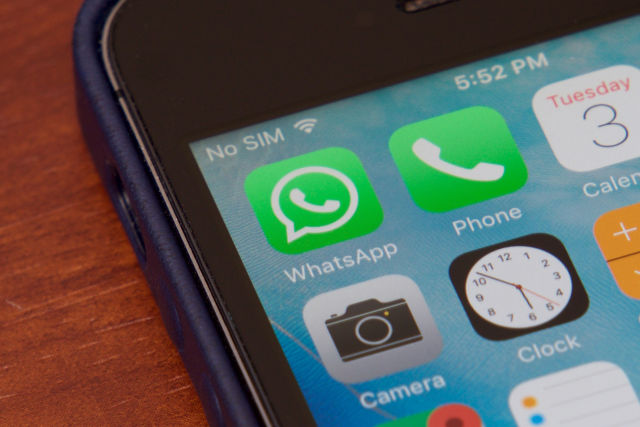 Having read the European Commission’s original ruling, some prior rulings, the Treasury’s white paper about the European Commission’s actions and a lot of analysis in the tax community, in my opinion, the EC is over-reaching in their decision on Apple. Read More
Having read the European Commission’s original ruling, some prior rulings, the Treasury’s white paper about the European Commission’s actions and a lot of analysis in the tax community, in my opinion, the EC is over-reaching in their decision on Apple. Read MoreShared posts
Apple done nothing wrong
 Having read the European Commission’s original ruling, some prior rulings, the Treasury’s white paper about the European Commission’s actions and a lot of analysis in the tax community, in my opinion, the EC is over-reaching in their decision on Apple. Read More
Having read the European Commission’s original ruling, some prior rulings, the Treasury’s white paper about the European Commission’s actions and a lot of analysis in the tax community, in my opinion, the EC is over-reaching in their decision on Apple. Read MoreUK’s Top Police Warn That Modding Games May Turn Kids into Hackers
Last week at EGX, the UK's biggest games event, attendees got a chance to play upcoming blockbusters like Battlefield 1, FIFA 17, and Gears of War 4. But budding gamers may also have spotted a slightly more unusual sight: a booth run by the National Crime Agency (NCA), the UK's leading law enforcement agency.
Over the last few years, the NCA has attempted to reach out to technologically savvy young people in different ways. EGX was the first time it’s pitched up to a gaming convention; the NCA said it wanted to educate young people with an interest in computers and suggested that those who mod online games in order to cheat may eventually progress to using low level cybercrime services like DDoS-for-hire and could use steering in the right direction.
Our NCCU officers are at @EGX until Sunday promoting ethical hacking & developing coding skills. Come say hi! #cyberchoices #EGX2016 pic.twitter.com/tubDnlYchS
— NationalCrimeAgency (@NCA_UK) September 22, 2016
“The games industry can help us reach young people and educate them on lawful use of cyber skills,” Richard Jones, head of the NCA's National Cyber Crime Unit’s 'Prevent' team, told Motherboard in an email.
“Through attendance at EGX and various other activities, we are seeking to promote ethical hacking or penetration testing, as well as other lawful uses of an interest in computers to young people,” Jones said. Penetration testing is essentially hacking done with the consent of the target company, usually done in an effort to uncover vulnerabilities which the company can then fix.
Read More: The UK Wants Gamers to Fix Its Cybersecurity
Jones said that the EGX presence wasn't part of an NCA recruitment campaign, and there aren't any specific ethical hacking jobs at the agency.
“The conversations we have been having with younger attendees have been about promoting career pathways into gaming, cyber security, or law enforcement, where they can use their cyber skills positively to have interesting and prosperous careers. Where needed, we have also explained that certain online activity is illegal and there are consequences for victims,” Jones added.
In December, the NCA announced that the average age of cybercrime suspects over the last year was 17 years old, compared to 24 the previous year. The agency has a particular interest in reaching those who cheat at online games, suggesting they may eventually dabble in criminal activities.
“We have undertaken analysis on pathways into cyber crime offending and can conclude that some young people who have an interest in online games may begin to participate in gaming cheat websites and ‘modding',” Jones said. “This has the potential to progress to criminal hacking forums and use of low level cybercrime services like DDOS for hire. We are therefore at the event to speak to young people who may be vulnerable to becoming involved in cybercrime and promote lawful career pathways.”
Holly Nielsen contributed reporting.
Get six of our favorite Motherboard stories every day by signing up for our newsletter.
This running back has the NFL's funniest Twitter avatar by far

We're still laughing.
Baltimore Ravens running back Justin Forsett has only made one Pro Bowl in his eight-year NFL career, but he is now the league's undisputed Twitter-avatar MVP.
He don't make the law, you see ... he Justin Forsett.

Image: @JForsett/twitter
The very good joke was brought to the internet's attention Wednesday on — where else? — Twitter by Luke Rodgers of 247Sports. We're grateful for it.
Justin Forsett's new twitter avatar is the GOAT@JForsett pic.twitter.com/fksibwUQxl
— Luke Rodgers (@thelukerodgers) September 21, 2016
As the youths say on Twitter: WHO DID THIS?!?
Forsett's publicist relayed this additional background from the Ravens running back: "The slogan started when I played in Seattle but someone made the meme about a year ago. I wanted to do something different with my profile picture, so I chose to screenshot the pic and use it." Read more...
More about Nfl, Sports, and EntertainmentWhat has Trump lied about today, chart edition, Sept 21

Part of an ongoing series by weird chart-maker Scott Bateman; link to today's edition.
AI Can Recognize Your Face Even If You’re Pixelated

Raspberry Pi's new microcomputer is 10x faster than before

Raspberry Pi is the microcomputer revolutionizing computer science and programming across the globe. Apart from being super fun to build projects like robots and RC cars with, Raspberry Pi is also an interactive way to learn to program. There's no better time than the present to start tinkering with Raspberry Pi, as they recently released the new and improved version 3.
The Boing Boing store is even offering a full Raspberry Pi 3 Kit complete with everything you need to take full advantage of the Raspberry Pi’s considerable computing and processing power. You can link it up with the included SainSmart LCD display to compute more easily, control your Raspberry Pi directly from the board controller (also included), and connect to the internet or Bluetooth right out of the box.
In no time, you’ll be coding more complex programs and apps, like music makers and weather stations, and you’ll be doing it all with the functionality of your own mini-supercomputer.
Plus, since it comes packing Quad-Core 1.2 GHz CPU and 1 GB of RAM, you’ll never have to worry about how much the Raspberry Pi can handle. It’s as easy as pulling out the included quick start guide and getting started.
For a limited time, the Raspberry Pi 3 Complete LCD Display Kit is just $114.99.
The carbo-licious sixth taste

You aren't just craving mac and cheese and creamy mashed potatoes because they sound tasty. You actually love the taste of starch.
Along with salty, sour, sweet, bitter and umami, "starchy" could be the next officially recognized taste.
At least, that's the thinking behind a study led by Oregon State University's Juyun Lim. When she served volunteers different carbohydrates, they were able to taste starch in both long and short carbohydrate chains.
“Asians would say it was rice-like, while Caucasians described it as bread-like or pasta-like. It’s like eating flour," Lim tells New Scientist. Read more...
More about Food and WatercoolerTrump Finally Says Something Coherent About ‘the Cyber’

How we generated $712,076.64 in revenue with two people in a little over two years
JvitakPerhaps of interest to the QSI folks.
Detailing Know Your Company’s most unusual business model… that works! We’ll go behind the scenes and share the numbers to show you exactly how we’ve done it.

“Can I ask you a weird question, Claire?”
“Sure,” I reply.
“How do you make any money?”
I get asked this question fairly often. People hear about the pricing model for our software, Know Your Company, and they’re a bit perplexed.
We charge $100 per employee, one-time, for life. That’s it. So if you’ve got 20 employees, it’s $2,000. You pay that once and that’s it. No recurring costs, maintenance fees, etc. The only time you ever pay again is if you hire someone new. Then it’s $100 for that new person.
It’s weird, I’ll admit. With software, you typically see a subscription-based pricing model. Say, $5 per user per month. Or maybe just $100 per month for unlimited usage.
To most, a one-time, per-person fee sounds like we may be leaving money on the table.
Why would we ever price something this way? Does it work?
We’re now two-and-a-half years into running Know Your Company as our own separate company (we spun off from Basecamp in December 2013) and I want to share the answers to those questions. Here’s the nitty gritty on the reasoning behind our business model and how it’s been going. Read on and I’ll share our revenue numbers, customer retention numbers, etc.
First off, why did we price the software this way?
The biggest reason we went with one-time pricing, versus a subscription model, is because it best aligns with the value we’re trying to create.
I believe that a business owner should get feedback from an employee for the entire time that she or he is at the company. Not just for a few weeks or months — but for how ever many years an employees is with you.
A subscription model doesn’t encourage this. It’s easy to go for a few months using a product, paying, say, $50 a month, and then turn it off. In the case of Know Your Company, it’d be even easier. It’d be convenient to get a piece of feedback you don’t particularly like, and say, “Ahh I don’t need to hear this right now,” and turn off Know Your Company.
But for me, that’s not good enough. If you’re truly invested in creating the best environment for your employees, you’re getting feedback from your employees for life. Our pricing model encourages CEOs to start to see getting feedback in this way.
Our one-time pricing model also brings an advantage a subscription model doesn’t have: It encourages a high commitment from CEOs when they use the product. When you’re putting in $3,000 one-time upfront, versus $30/month or $300/month, you’ve got some skin in the game. So now you’re more determined to see that value returned to you on the other end.
As a result, CEOs put more energy behind Know Your Company when they roll it out. They talk it up to their employees, and they act on the feedback that comes from the software. Know Your Company becomes an initiative, a program — not just another web app they’re playing around with. And these CEOs see meaningful outcomes in their company because of it. For us, it’s been extraordinarily helpful that our pricing model helps influence the outcomes we want our customers to have.
So do we make money doing this? Let’s pull back the curtain on our numbers…
Since becoming our own standalone company in January 2014, we’ve generated $712,076.64 in revenue. We’re profitable — our average monthly profit margins are at a healthy 30%.
More than 200 companies have purchased our product, and 12,000+ employees use Know Your Company every day in more than 15 different countries across the world.
We do this all as a two-person company. It’s just me as the CEO, and our programmer, Matt De Leon.
We’ve never taken a cent of funding from outside investors. When we spun off from Basecamp a few years back, they didn’t give us any cash or team members — just the product and the existing customer base the product had acquired at that point.
Our customers are companies who typically have between 25 and 75 employees. The average size is 31 employees. Our smallest customer has six employees, and our biggest has 380 employees. (They were at around 70 employees when they first started using Know Your Company.) The industries of companies range across the board — from software to retail to hotels to ad agencies to nonprofits. We even work with a few churches.
The biggest surprise though: where our revenue has come from. Last year, 70% of our revenue came from existing customers adding new employees to the system, as their companies have grown. About 50 new employees were added every week by existing customers. The remaining 30% of our revenue resulted from new companies signing up for Know Your Company.
In other words, 70% of our revenue in 2015 was “recurring.” That’s more than two-thirds of our revenue generated off a business model where we’ve got one-time pricing per user.
So while the pricing model doesn’t inherently feel like there is a recurring component — there is. And it’s directly tied to the value that we’re creating for our customers. We’re supporting them as they grow and become more successful.
How this one-time pricing model has been helpful for us
Over the past two and half years, we’ve built a solid, profitable, bootstrapped company with just a two-person team. And our pricing model has absolutely enabled that.
I didn’t realize it when we started, but our pricing model has played a large role in helping us become profitable as a bootstrapped company early on and continue to stay profitable.
Our one-time pricing has allowed us to see cash a lot sooner than if we were operating on a monthly subscription pricing model. As a bootstrapped company, cash flow is the lifeline we depend on. On average, an initial $3,100 invoice is paid out to us the first week a new customer comes onboard. That’s significant. With a subscription model, how many months would we have to wait until we see that same $3,100?
Some might argue, though, while we’re able to capture a large portion of cash upfront, we’re missing out on the entire lifetime value that a monthly subscription model would capture. I initially had concerns about this, myself. However, the math proves something different.
For us with our current one-time pricing model, the average lifetime value of a customer is about $4,600 per customer. Companies add an average of 15 employees to our software during the time they use Know Your Company. The average amount of time a customer stays with us is 19 months.
To attain that same average lifetime value of $4,600 with a subscription model (let’s say we were to charge $5 per employee per month), we‘d need a customer to stay with us for about 30 months.
Thirty months is a much longer time than 19 months. And while I’d love for a customer to stick with us for two-and-a-half years, right now the average customer uses us for one year and seven months. Plus, with a one-time model, we see 67% of that lifetime value upfront. No waiting on our end required.
In fact, this one-time pricing model is what has gotten us to profitability so quickly as a bootstrapped company. We became profitable during our first month of running Know Your Company as a separate company because of this pricing model.
Allowing us to capture a larger chunk of the lifetime value upfront has also afforded us to take our time. We’re not in a rush to scoop up as many customers as we possibly can, regardless of whether we’re a good fit for them or not. Rather, we can focus on taking on customers we believe we can actually help, ensuring we’re truly solving their problem and serving them well.
Our one-time pricing model gives us room to treat each customer with thoughtfulness and personal care. Whether that’s sharing data on the best questions to ask employees, providing questions that other CEOs have asked through Know Your Company, or adding them to a Basecamp Project where there are hundreds of other customer CEOs — we’re able to pour ourselves into making sure our customers get the most out of Know Your Company. And these investments for our customers have paid off. Last year, we had a 98% retention rate. (Unfortunately, we had one company decide to stop using the product.)
This isn’t to say that a subscription model and solving your customers’ problems are mutually exclusive. Instead, I just want to share how for us, a business that’s getting off the ground, trying to get its legs under it, this is something that’s worked well.
It’s still not easy
Let’s be clear: A one-time pricing model doesn’t make everything easier. Running a business is still tremendously hard for us, even with this pricing model.
While we can capture a large chunk of lifetime value upfront, we still run a very, very lean business in order to be profitable. One of the ways I try to reduce overhead is that I don’t pay office rent. Basecamp is kind enough to let me work out of their office a few days a week over in the West Loop in Chicago, free of charge. I use a table in a conference room they don’t use very often, and I try to minimize getting in anyone’s way. It’s generous of them and an arrangement for which I’m grateful. You might be able to propose something similar and borrow an unused table at a friend’s office. (It never hurts to ask.) Or, you can always work from home to save on office rent — which is what I do about 50% of the time.
Another way I’ve reduced overhead is that I’ve only hired one other person (Matt, our programmer, who I mentioned earlier). Perhaps we could afford to bring on another person, be it part-time or full-time. But I’m highly cognizant of the costs — in salary dollars, and also in time and training. I’ve watched fellow friends who are business owners hire too quickly, and I’ve seen the strain that puts on the business. Get too big too fast, and it’s hard to rewind.
It’s also taken us an arduous, painstaking two-and-half years to hit $700K in cumulative revenue. Up until two months ago when we moved to self-signup, if a business owner was interested in purchasing Know Your Company, she or he had to do a 30-minute in-person demo with me via GoToMeeting, Skype, or WebEx. Not a demo with a salesperson — but with me, every time. In fact, I’ve done almost 500 of these in-person demos over the course of two-and-a-half years!
Every single Know Your Company product feature we shipped was conceptualized, designed and engineered by Matt and me. Every single article written, marketing site redesign, social media push, conference talk (I’ve spoken at more than 30 conferences, CEO groups, company events, etc.), and conference partnership was something the two of us executed. All the support requests, account setup, account management, invoicing, billing for 200+ companies with 12,000+ employees in 15 countries — were handled by just two people.
Matt and I have pushed ourselves to do everything we can as a two-person team, ever mindful of staying profitable each month. And we’re still wary about bringing someone else on board. When we do, we want it to be measured and truly, truly needed. (We only recently brought on a part-time data intern for the summer.) Yet it works for us.
I prefer our slow, intentional, in-control growth. It gives me the time, focus, and energy to feel we are doing right by our customers, creating the best product possible, and building company that lasts for the long haul. (My goal is to run Know Your Company for the next 10, 20 years, if I can!) And our pricing model supports that.
As a two-person company, with more than 200 customers, $700K in cumulative revenue, less than three-years-old, profitable, and bootstrapped… I’m proud of how far we’ve come.
Plus, with our recent move to self-signup, things are looking up, more than ever. Last month, we had our biggest month of sales to date… and we’re on pace to hit $1 million in cumulative revenue by the end of the year (fingers crossed!).
Will it work for you?
Who’s to say that this exact pricing structure will work for your business.
But here’s what I will say: if you focus on helping your customers get the outcomes they want and keeping your overhead low, there’s a clear path to profitability.
What matters less is if the pricing model you’ve decided on is “popular” or not for your industry. Who cares if the way you price something or the way you sell something or the way you run your business is unconventional. Who cares if people are saying to you, “Can I ask you a weird question?”
What’s most important is that you’re running a business on your own terms and providing real value to people by making some aspect of their lives better.
I hope by sharing our numbers — and making ourselves a bit naked — it’ll help you reach your own conclusions as to whether this one-time pricing — or another model — is something that will work for you.
So, to anyone out there who’s starting a business and trying to figure out how to make money and have an impact on others: Charge people what you think it’s worth, do what you can with what you have, and focus on doing a really damn good job.
Was this post interesting or helpful to your business? If so, please click the ❤ below to let me know or say hi on Twitter (@cjlew23)! I’m happy to share more behind-the-scenes of how we run our two-person bootstrapped software company, if that’s something you’re intrigued about.
You can also check out how Know Your Company might be helpful in running your own small business. Give us a try completely for free for two weeks. You can also read more of what I’ve written for small business owners, or watch the talks I’ve given.
How we generated $712,076.64 in revenue with two people in a little over two years was originally published in Signal v. Noise on Medium, where people are continuing the conversation by highlighting and responding to this story.
Read the responses to this story on Medium.
Sports car owner chases down skater who smashed his windshield

It's the classic story. A $250,000 McLaren sports car runs a stop sign and knocks down a kid on a skateboard. The passengers rudely yell at the skater to move, and he promptly smashes their windshield in a fit of righteously petty revenge before running off.
The man in the passenger seat, who paid a small fortune and likely part of his soul for that windshield, doesn't take the insult sitting down. The last we see of him and the skater are the two chasing each other off into the sunset.
It's unclear who'd win this sort of squabble. The skater had the right of way before being knocked over, but the other guys are rich. So, this could be anyone's game. Read more...
Starbucks barista found a new way to troll annoying customers
JvitakPassive-aggressiveness at its finest.

Simply spelling customer's names wrong was getting old for one barista.
Barista and Reddit user bemyfuse posted a photo explaining the newest way to mess with annoying Starbucks customers — covering the cup's logo with the order sticker.

Image: bemyfuse/reddit
"My petty joy is putting stickers on the siren logo when annoying teenagers order millions of fraps at once so their Instagram posts are ruined ¯\_(ツ)_/¯ it's the little things," bemyfuse captioned the photo.
A key part of a perfect Starbucks Instagram photo is, of course, the giant Starbucks logo. Read more...
Jill Stein Pledges To Pardon Snowden and Appoint Him To Her Cabinet
Read more of this story at Slashdot.
RNC official defends Melania Trump by quoting 'My Little Pony'

While the world reels from last night's baffling case of apparent plagiarism by Melania Trump, Republican strategists are doing their best damage control. Unfortunately, it doesn't look their best is quite up to snuff.
Trump has denied that she did anything untoward in writing her speech, and other Trump officials have similarly denied the charges.
Meanwhile, RNC communications director Sean Spicer appeared on CNN this afternoon to continue the defense of Trump's speech but did so by comparing bits of her speech to phrases that have been used by other big names, including John Legend, Kid Rock and Twilight Sparkle, a My Little Pony. Read more...
Couples who get drunk together, stay together, according to a new study
JvitakSweet!!

Drink up, couples of the world — it may save your relationship.
People are constantly trying to find new methods and hidden secrets behind the success of a relationship. Is it understanding? Courtesy? Patience? Turns out it's alcohol.
According to a study published in The Journals of Gerontology Series B: Psychological Series, couples who drink alcohol together reported a less negative relationship quality over time, and the results were "significantly greater among wives."
The study found that couples over the age 50 had better marriages if both couples drank or if both couples abstained from drinking. However, if one person in the relationship remained sober while the other drank, couples were more likely to report of an unsatisfied marriage, especially wives. Read more...
Researcher Finds Way To Steal Cash From Google, Instagram, and Microsoft Through The Phone
Read more of this story at Slashdot.
Baseball exec gets 46 months in prison after guessing rival team’s password
JvitakWow.

(credit: Brian Wibbenmeyer)
A former executive for the St. Louis Cardinals baseball team, Christopher Correa, was sentenced Monday to 46 months in prison. In 2013, he successfully guessed a password to access an online database for confidential data held by another baseball team, the Houston Astros.
Correa pleaded guilty earlier this year to five counts under the Computer Fraud and Abuse Act, a notorious 1980s-era hacking statute.
“You have made it harder for them to live their lives,” US District Judge Lynn N. Hughes said during the court hearing, referred to the necessity of tighter security around all of Major League Baseball.
Google’s latest transparency report shows record government data requests
 Google saw a record number of data requests from law enforcement agencies worldwide during the second half of 2015 as the request total passed the 40,000 mark for the first time. That’s up from 35,365 in the first half of the year and 30,140 one year previous, according to the tech giant’s latest transparency report. Read More
Google saw a record number of data requests from law enforcement agencies worldwide during the second half of 2015 as the request total passed the 40,000 mark for the first time. That’s up from 35,365 in the first half of the year and 30,140 one year previous, according to the tech giant’s latest transparency report. Read MorePakistan bars social media star Qandeel Baloch's family from forgiving her brother

In an important step against honour killings, Pakistani authorities have barred the parents of slain social media celebrity Qandeel Baloch from forgiving their son for her murder. Currently, a loophole in the country's legal system permits the relatives of victims to forgive their assailants, often resulting in their acquittal.
SEE ALSO: Pakistani social media star Qandeel Baloch's brother confesses to killing her for 'honour'
Baloch was strangled and murdered by her brother Muhammad Waseem at their family home in Multan on the early hours of July 16. Waseem had earlier said that he had "no regrets" for the murder, as Baloch had brought "dishonour" to the family with her videos, photographs and social media posts. Read more...
A New Service Alerts You When Someone Uses Your Social Security Number

US congressman Steve King thinks white people are the most awesome "subgroup"

Iowa congressman Steve King Steve King of Iowa loves his "sub-group" of people. Here's what he said on a televised panel on MSNBC:
“This whole ‘old white people’ business does get a little tired, Charlie. I’d ask you to go back through history and figure out where are these contributions that have been made by these other categories of people that you are talking about? Where did any other subgroup of people contribute more to civilization?”
“Than white people?” Mr. Hayes asked.
Mr. King responded: “Than Western civilization itself that’s rooted in Western Europe, Eastern Europe and the United States of America, and every place where the footprint of Christianity settled the world. That’s all of Western civilization.”
Even if King's proudly ignorant statement was true, which it most assuredly is not, the fact remains that King himself hasn't invented anything, other than fabulist history. To be proud of someone else's invention because you have the same color skin as them is just about the stupidest thing a human being could think. It's unfortunate that this nincompoop has enough admirers to vote him into office.
Quartz put together a list of things not invented by white people. I wonder if Rep King sullies his hands by touching any of them?
- numerals
- mathematics
- religion
- Christianity
- irrigation
- novels
- paper
- ink
- dance
- music
- gunpowder
- guns
- bombs
- time bombs
- the seismograph
- the compass
- just-in-time manufacturing
- CD players
- MP3 players
- Pokemon
- calculators
- karaoke
- lithium ion batteries
- yoga
- martial arts
- silk
- umbrellas
- tea
- noodles
- instant noodles
- shampoo
- punk futurism
- futures markets
Better Facial Recognition Tech Could Lead to Robot Hitmen
From catching thieves to finding lost pets, facial recognition technology has already done a fair bit of good for humanity. But artificial intelligence experts warn new developments in the field could soon trigger a more troubling use of facial recognition software: weapons that function like robot hitmen, complete with "vision" as accurate as the human eye.
The controversial new technology is poised to hit the market in a few years and could spark "a third revolution in warfare," said the University of Montreal’s Yoshua Bengio, who leads the foremost research group on the powerful AI technique known as deep learning.
Unlike weaponized drones, which remote human pilots use to target geographic areas based on various “signatures” of people the US government believes to be militants, Bengio predicts the killing machines of the future will be precise enough to recognize—and take out—a single person in a crowd of thousands. And perhaps the most frightening difference is that tomorrow’s killer robots could act on their own, pulling the trigger with no human being in the loop, he added.
"There could be an arms race for these types of things,” Bengio told me. “In the wrong hands, it could be used in a way that’s against our ethics. It could be used to eliminate someone, like poof.”
This kind of autonomous assassin would be able to roll or fly. It could be as big as a quadcopter or as small as a bird, programmed to hunt down a person by matching his or her face to a database of images. Bengio said this sort of tech will first be used by the military or law enforcement, possibly in a matter of years.

Photo: CSKR/Flickr
The sort of robotic hitmen that Bengio warns of don’t yet exist, although the mere thought of the technology, optimized with enhanced facial recognition capabilities, presents a knot of privacy and ethical concerns.
On July 7, after a sniper gunned down five Dallas police officers at a Black Lives Matter demonstration, police used a “bomb robot” to kill a suspect on American soil for the first time ever. Although a human being drove the explosive-rigged robot and pulled the trigger, it's a dramatic reminder that machines are capable of doing humanity’s dirty work at home and abroad. The incident raises serious questions about due process and law enforcement use of remotely triggered lethal force. What is an “imminent threat” anyway and at what point can police decide to send in a robot, not a person?
In the future, law enforcement will likely collect the images of American citizens—possibly even those without criminal records—for databases, critics have predicted.
As of now there’s no legislation to ban lethal autonomous weapons anywhere in the world, but advocacy groups like the Campaign to Stop Killer Robots are pushing for an international treaty to stop the development of lethal fully autonomous weapons. The farther removed humans are from the frontlines of war, the easier it is to kill, according to the CSKR.
“It is crucially important for the international community to establish a norm that prohibits delegating the authority to take human lives to machines,” Peter Asaro, a representative for the campaign, told me.
Meanwhile, in recent years researchers have made sweeping advances in the speed and accuracy of facial recognition systems. The systems analyze the characteristics of a person's face, including distances between the eyes, nose, and mouth, before matching that to a database of images. Scientists have unlocked the secrets to using the tool successfully at greater distances with less light, and even in the dark.
"It might take time to engineer such a device, but the basic science exists, at least on the AI side—and I don't see why not on the robotic weapon side”
In Bengio’s field of deep learning, which seeks to create machines that mimic the human brain, computers are getting smarter when it comes to facial recognition. When a computer detects only half of a face, for example, it can use machine learning to guess the rest, according to Bengio and other deep learning experts.
Scientists already have access to the technology needed to create a robot hitman, Benigo and other experts said. Now, it’s only a matter of building one. "It might take time to engineer such a device, but the basic science exists, at least on the AI side—and I don't see why not on the robotic weapon side,” he said.
Bengio isn’t aware of any firm that has gone public with a plan to build lethal weapons that target specific individuals autonomously, he said. But US military operations are depending more and more on robotic technology to carry out “kill lists,” according to “The Drone Papers” published last year by The Intercept. On the law enforcement side, the company Taser International plans to build police body cameras that use facial recognition to nab suspects.
Even scientists at the forefront of AI are alarmed by the possibilities. Thousands of respected scientists—including Stephen Hawking and Noam Chomsky—came together last July in an open letter that called for a global ban on autonomous weapons. In their letter, the signatories urged lawmakers and tech honchos to proceed with caution by supporting international agreements to ban building the weapons.
“The stakes are high: autonomous weapons have been described as the third revolution in warfare, after gunpowder and nuclear arms,” reads the letter, which is signed by Bengio and 17,700 other people. “Starting a military AI arms race is a bad idea, and should be prevented by a ban on offensive autonomous weapons beyond meaningful human control.”
In April, representatives from 14 countries and regions, including Zimbabwe, Pakistan, and Palestine gathered at an informal meeting of experts at the United Nations to demand a preemptive ban on robotic killing machines. The meeting helped the campaign earn more supporters worldwide, a rep for the group said: “Momentum is building rapidly.”
In December, Algeria, Chile, Costa Rica, Mexico, and Nicaragua will consider will consider whether to adopt the ban.
Stephen Colbert brought back his 'Colbert Report' persona to cover the RNC

Yesterday's glimpse into Stephen Colbert "crashing" the Republican National Convention did not adequately prepare us for The Late Show with Stephen Colbert's hilarious full coverage of his adventures.
Colbert, dressed as The Hunger Game's Caesar Flickerman but evoking The Colbert Report's Stephen Colbert, wandered the Quicken Loans Arena, brilliantly poking fun at the Republican party, past candidates, Trump's wall plans, gendered bathroom laws, racism and more.
We're really glad to have the old Stephen Colbert back to get us through this election.
Brazil’s Federal Supreme Court lifts WhatsApp block [Updated]

(credit: Andrew Cunningham)
UPDATE 6:45pm ET: Reuters reports that Brazil's Federal Supreme Court has now suspended the ruling by the lower court judge, which ordered mobile phone carriers to block access to WhatsApp.
“We're pleased that people can access WhatsApp again in Brazil," Matt Steinfeld, a WhatsApp spokesman, e-mailed Ars in a statement.
Our original story follows:
Autopilot was off when Tesla Model X in Pennsylvania crashed
 The Tesla Model X that crashed in Pennsylvania on July 1 had autopilot disabled at the time, Elon Musk announced on Twitter. This info comes straight from the vehicle’s own logs. Read More
The Tesla Model X that crashed in Pennsylvania on July 1 had autopilot disabled at the time, Elon Musk announced on Twitter. This info comes straight from the vehicle’s own logs. Read MoreThese Discounted Copper String Lights Can Dim, Strobe, and Pulse on Demand

It’s a scientific fact that every outdoor space looks better with copper string lights, and while $15 isn’t a tremendous price for a 33' strand with 100 bulbs, this set does include a remote that can power them on and off, and even force them to dim, pulse, and strobe on demand.
Hot and confused pup enjoys a mid-air swim
JvitakCairns are the cutest.

Ignorance is bliss, and so are kiddie pools.
One adorable Cairn Terrier is so excited to cool off that after his human hovers him just above water, he thinks he's swimming and does his best doggy paddle — in midair.
You'll find this just as amusing as the cackling boy in the kiddie pool.
This $7 Charger Is a No-Brainer Upgrade From Apple's iPhone Power Brick

You know the little charging brick that came with your phone? Throw it out, and spend $7 on this replacement from Aukey (with code IBEEGE8R). It’s basically the same size as Apple’s standard iPhone charger, but it includes two ports, folding prongs, and 2.4A of current (instead of 1A) to charge your devices faster.
The Unfalsifiability of Security Claims
Interesting research paper: Cormac Herley, "Unfalsifiability of security claims:
There is an inherent asymmetry in computer security: things can be declared insecure by observation, but not the reverse. There is no observation that allows us to declare an arbitrary system or technique secure. We show that this implies that claims of necessary conditions for security (and sufficient conditions for insecurity) are unfalsifiable. This in turn implies an asymmetry in self-correction: while the claim that countermeasures are sufficient is always subject to correction, the claim that they are necessary is not. Thus, the response to new information can only be to ratchet upward: newly observed or speculated attack capabilities can argue a countermeasure in, but no possible observation argues one out. Further, when justifications are unfalsifiable, deciding the relative importance of defensive measures reduces to a subjective comparison of assumptions. Relying on such claims is the source of two problems: once we go wrong we stay wrong and errors accumulate, and we have no systematic way to rank or prioritize measures.
This is both true and not true.
Mostly, it's true. It's true in cryptography, where we can never say that an algorithm is secure. We can either show how it's insecure, or say something like: all of these smart people have spent lots of hours trying to break it, and they can't -- but we don't know what a smarter person who spends even more hours analyzing it will come up with. It's true in things like airport security, where we can easily point out insecurities but are unable to similarly demonstrate that some measures are unnecessary. And this does lead to a ratcheting up on security, in the absence of constraints like budget or processing speed. It's easier to demand that everyone take off their shoes for special screening, or that we add another four rounds to the cipher, than to argue the reverse.
But it's not entirely true. It's difficult, but we can analyze the cost-effectiveness of different security measures. We can compare them with each other. We can make estimations and decisions and optimizations. It's just not easy, and often it's more of an art than a science. But all is not lost.
Still, a very good paper and one worth reading.




![[After setting your car on fire] Listen, your car's temperature has changed before. [After setting your car on fire] Listen, your car's temperature has changed before.](http://imgs.xkcd.com/comics/earth_temperature_timeline.png)


